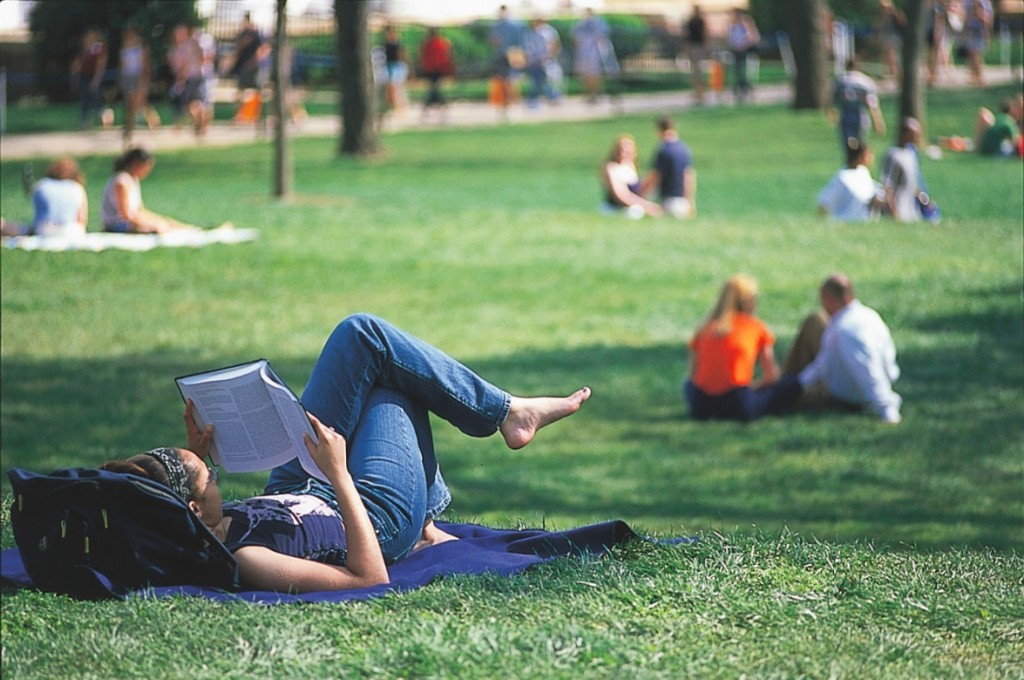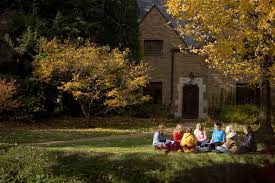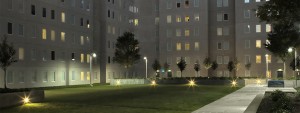 Relaxation and stress in atlanta based on the built environment
Relaxation and stress in atlanta based on the built environment
Encounters with nearby nature help alleviate mental fatigue by relaxing and restoring the mind. Within built environments parks and green spaces are settings for cognitive respite, as they encourage social interaction and de-stressing through exercise or conversation, and provide calming settings. Having quality landscaping and vegetation in and around the places where people work and study is a good investment. Both visual access and being within green space helps to restore the mind’s ability to focus. This can improve job and school performance, and help alleviate mental stress and illness.
 Our environment can have both negative and positive subconscious effects. A look at an object that even remotely resembles a snake, for instance, may initiate an instantaneous fear response. Similarly, the presence of plants subconsciously and beneficially impact how the brain responds even when we do not focus attention on such surroundings. In today’s lifestyles and work, we must focus our attention on critical information or tasks. Maintaining that focus by screening out distractions overloads our capacity for conscious attention. Yet, exposure to settings that are visually interesting (“high fascination”) have been found to aid directed attention recovery. Comparing memory retention in people viewing low versus high fascination scenes in built and natural environments, respectively, people viewing natural environments performed significantly better. So, in the case of offices and schools, where one must focus on tasks, the addition of natural features could significantly improve attention and content retention rates.
Our environment can have both negative and positive subconscious effects. A look at an object that even remotely resembles a snake, for instance, may initiate an instantaneous fear response. Similarly, the presence of plants subconsciously and beneficially impact how the brain responds even when we do not focus attention on such surroundings. In today’s lifestyles and work, we must focus our attention on critical information or tasks. Maintaining that focus by screening out distractions overloads our capacity for conscious attention. Yet, exposure to settings that are visually interesting (“high fascination”) have been found to aid directed attention recovery. Comparing memory retention in people viewing low versus high fascination scenes in built and natural environments, respectively, people viewing natural environments performed significantly better. So, in the case of offices and schools, where one must focus on tasks, the addition of natural features could significantly improve attention and content retention rates.
Learning, like tasks at work, requires focused, direct attention and high-level cognitive functioning. When plants were added to a college computer lab, the study participants were more productive (with 12% quicker reaction times on tested computer tasks) and showed less stress though there was no difference in number of errors made on the test. Additionally, participants reported feeling more attentive and better able to concentrate in the presence of plants. In other studies, participants performed better on creative tasks in rooms having foliage plants, versus those without, and the authors conclude that nature may provide inspiration and a source of stimulation for creativity. College students with more natural views from their dorm windows scored higher on tests of capacity to direct attention (CDA) and rated themselves as able to function more effectively. In another study of college students, those who participated in a nature walk performed higher on a subsequent CDA test than those who went on an urban walk or relaxed in a comfortable room with magazines a nd light music prior to the test.
nd light music prior to the test.
In recent times, children have less opportunity to be outdoors, in terms of both time and space. Some schools provide nature experiences as part of a class, recess, or special activity, as they recognize the potentially significant affects on learning and mental health. Educational theory suggests that contact with nature facilitates children’s development of cognitive, emotional, and spiritual connections to social and biophysical environments around them. Ecological theory also suggests that contact with nature is important for children’s mental, emotional, and social health because imagination and creativity, cognitive and intellectual development, and social relationships are encouraged in outdoor activity, all of which improve the child’s mental health and function.
Nature can provide both background and objects for play and learning. Among older children, exposure to nature encourages exploration and building activities, which can improve problem-solving abilities, ability to respond to changing contexts, as well as participation in group decision-making. Younger children often use outdoor settings having plants, stones, and sticks as props for imaginative play, which is key to social and cognitive development. One study of children’s play found that a cluster of shrubs was the most popular place to play on an elementary schoolyard because it could be transformed into many imaginary places: a house, spaceship, etc.
Office workers may spend entire days indoors, and many decorate their workspaces with plants or pictures of natural settings to compensate for lack of a window view. In one study, people in windowless workspaces introduced twice as many nature elements to their work area as those who had window views of natural areas.
Office workers report that plants make for more attractive, pleasant, and healthy work environments, but what impact do plants and nature views have on work performance? Studies show improved employee morale, decreased absenteeism, and increased worker efficiency result from such workplace enhancements. Having plants within view of workstations decreases both illness incidence, and the amount of self-reported sick leave. One study found that workers with workstation views that included green elements were more satisfied at work and had more patience, less frustration, increased enthusiasm for work, and fewer health problems. Not having nature views or indoor plants are associated with higher levels of tension and anxiety in office workers.
In addition to physiological symptoms, stress can lead to depression, schizophrenia, anxiety, exhaustion, and fatigue syndromes. Stress can occur at any time in life, responses are especially prominent at later age due to physical, psychological, and social changes for example, in response to chronic disease, disability, death of loved ones, or financial hardship. Stress can also negatively affect people’s perceptions of their well being, including a poor perception of their own mental health. Physical activity has been linked to improvements in mental health and stress. Many studies connect urban park use to decreased stress levels and improved moods. In one study, the longer participants stayed in a park, the less stress they exhibited. More than 100 studies have shown that relaxation and stress reduction are significant benefits associated with spending time in green areas.
Depression also occurs at any age and can be helped through improved social connections (to decrease the feeling of isolation) and exercise, both of which are promoted by having nearby green outdoor spaces. In one study, 71% of people found a reduction in depression after going on an outdoor walk versus a 45% reduction by those who went on an indoor walk. Another study investigated major depression disorder (MDD) and found that an exercise program can be just as effective as antidepressants in reducing depression among patients. The value of green spaces in encouraging exercise is relevant to treating depression symptoms.
Couldn’t we simply substitute aspects of the natural world with technological depictions of nature? Can technology provide an adequate substitute in places where the natural world is some distance away?
When comparing subjects’ reactions in windowless offices with and without plasma TV “windows” showing natural scenes, participants preferred the offices with plasma-display windows and noted increased psychological well-being and cognitive functioning as a result of this connection to the natural world. In another study comparing viewing formats, outdoor views through glass windows were more restorative than blank walls, but plasma windows were no more restorative than blank walls to the subjects’ sense of well-being. Subjects’ heart rates were lower in offices with the glass windows than in those with plasma windows and blank walls.
It seems that artificially represented nature is not an effective substitute for directly perceived nature as it does not provide equivalent benefits and positive experiences. Such technological representations could be useful to some degree in situations where it is difficult to incorporate “real” nature, as in space shuttles, submarines, or other extreme environments where there is an unavoidable disconnect from the natural world.
A neighborhood than incorporates easily accessible green spaces into its design may also improve social cohesion and interaction. As a result, the mental health of individuals may also remain positive due to a decreased chance of depression and feelings of isolation and increased self-esteem. Effective social support networks have been found to restore feelings of personal control and self-esteem by buffering the effects of stress and poor health.
Green spaces, such as community gardens or even the shade of a large tree, encourage social contact by serving as informal meeting places and sites for group and shared activities. Green spaces can serve as a sort of ecotherapy, as marginalized people can find empowerment, respite from stresses, and personal involvement in environmental stewardship. Green spaces in close proximity to homes encourage exercise, which can improve mental health. As described earlier, studies indicate that having views of nearby nature and living within green spaces can improve worker productivity, reduce stress, improve school performance, and lessen the symptoms of ADD. Useable and safely accessible gardens or green spaces not only foster a sense of community, but also provide psychological benefits among its members.
Overall your surroundings affect you everyday life. No matter if you are just going to work or just shopping at your local grocery store. You shouldn’t put too much stress on yourself or else it can affect your health. Having just a little bit of nature or a breath of fresh air in your everyday life can restore relaxation and make you calm as well. When you continue with positive vibes around you, you will see a difference in your work and school life.
Berman, M.G., J. Jonides, and S. Kaplan. 2008. The Cognitive Benefits of Interacting with Nature. Psychological Science 19, 12: 1207-212.
Berto, R., M.R. Baroni, A. Zainaghi, and S. Bettella. 2010. An Exploratory Study of the Effect of High and Low Fascination Environments on Attentional Fatigue. Journal of Environmental Psychology 30, 4: 494-500.
Blumenthal, J.A., M.A. Babyak, K.A. Moore, W.E. Craighead, S. Herman, P. Khatri, R. Waugh, M.A. Napolitano, L.M. Forman, M. Appelbaum, D.P. Uurali, and K.R. Krishnan. 1999. Effects of Exercise Training on Older Patients with Major Depression. Archives of Internal Medicine 159, 19: 2349-356.
Chalfont, G.E., and S. Rodiek. 2005. Building Edge: An Ecological Approach to Research and Design of Environments for People with Dementia. Alzheimer’s Care Today 6, 4: 341.
Kaplan, R., and S. Kaplan. 1989. The Experience of Nature: A Psychological Perspective. Cambridge University Press, New York.
Heerwagen, J. 2009. Biophilia, health, and well-being. In: Campbell, L., and A. Wiesen (eds.), Restorative Commons: Creating Health and Well-Being Through Urban Landscapes. Gen. Tech. Rep. NRS-P-39. Newtown Square, PA: U.S. Department of Agriculture, Forest Service, Northern Research Station.
Heerwagen, J.H., and G.H. Orians. 1986. Adaptations to Windowlessness. Environment and Behavior 18, 5: 623.
Kaplan, R. 1993. The Role of Nature in the Context of the Workplace. Landscape and Urban Planning 26, 1-4: 193-201.